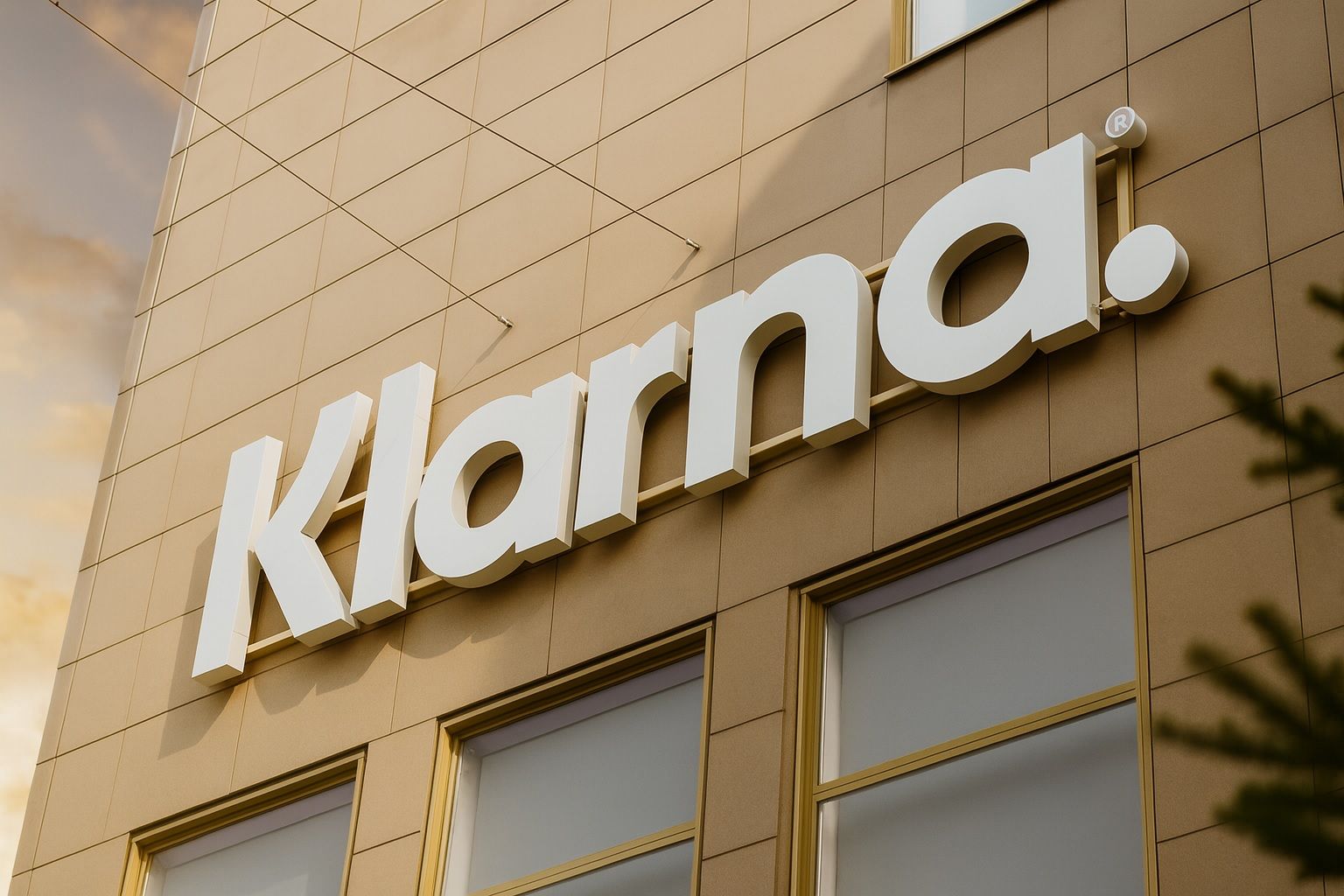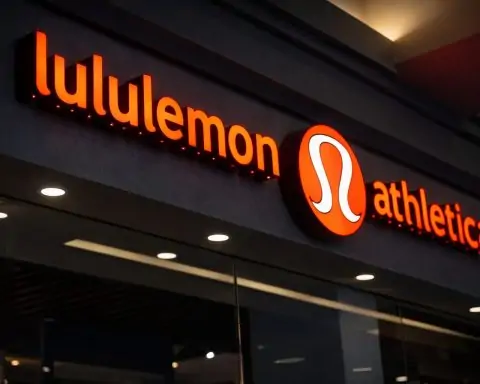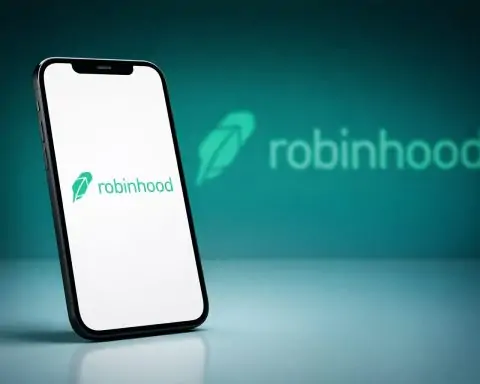- Wall Street Debut: Klarna went public on the NYSE in September 2025 under ticker “KLAR”, pricing its IPO at $40 per share and raising ~$1.37 billion [1]. The offering valued the Swedish buy now, pay later (BNPL) pioneer at about $15 billion, far below its 2021 private peak of $45.6 billion but well above its 2022 down-round valuation of $6.7 billion [2]. Shares surged ~30% on debut, opening near $52 [3].
- Stock Performance: After an initial pop, Klarna’s stock has fallen below its IPO price amid broader fintech volatility. As of mid-October 2025, KLAR trades in the mid-$30s (closing at ~$35 on Oct. 17) [4] – about 25% below its first-day close and intraday highs around $57 [5]. The company’s market capitalization is roughly $25–28 billion at current prices [6] [7]. Shares hit a low around $35.60 in early October during a market sell-off [8], though analysts note key support levels in the mid-$30s range.
- IPO Impact and Plans: Klarna’s NYSE listing (Sept. 10, 2025) marked one of the year’s biggest fintech IPOs, signaling a thaw in the IPO market. Oversubscription drove the final offer price above the initial $35–$37 range [9]. Management and early investors largely held their shares; CEO Sebastian Siemiatkowski (who owns ~7%) did not sell stock in the IPO, calling the debut “a little bit like a wedding… then life goes on” [10]. The listing, led by Goldman Sachs, JPMorgan, and Morgan Stanley, is seen as a bellwether for high-growth fintechs, alongside anticipated offerings from peers like Chime and Circle [11].
- Current Business Health:Klarna’s financials are improving after aggressive cost cuts. In Q2 2025, revenue grew ~20% year-on-year to $823 million [12], as gross merchandise volume and U.S. sales surged (U.S. revenue +38% YoY). The firm recorded its fifth consecutive quarterly operating profit ( ~$29 million adjusted operating income) [13]. However, on a net basis Klarna had a $53 million loss in Q2 [14] due largely to one-time charges (office closures, lease exits, and stock comp costs tied to the IPO) [15]. Credit performance is steady – loan default rates improved to under 1% of BNPL volumes [16] [17] – and Klarna boasts a BBB credit rating with $10.4 billion in cash reserves [18], reinforcing its balance sheet ahead of expansion.
- Valuation Context: Klarna’s public valuation reflects a comeback from its 2022 slump. Once Europe’s most valuable startup (at $45.6B in 2021), Klarna saw its valuation plunge ~85% to $6.7B amid the 2022 fintech rout [19]. The 2025 IPO valuation (~$15B) essentially doubled that trough [20], and subsequent trading has lifted Klarna’s market cap to the mid-$20B range. For comparison, U.S. rival Affirm – which went public earlier – commands a market cap around $22–24 billion as of October 2025 [21]. Some analysts argue Klarna is undervalued relative to Affirm, given Affirm’s ~23% stock rise this year [22]. Klarna’s IPO also underscores shifting market sentiment: investors are now favoring profitability and sustainable growth over the sky-high multiples of 2021’s fintech boom [23].
- Analyst Sentiment:Market sentiment is cautiously optimistic. Major brokerages initiated coverage on Klarna in early October with mostly bullish ratings. Goldman Sachs calls Klarna “the market leader in BNPL… with a particularly strong franchise in Europe” [24] [25], while J.P. Morgan labels it a “fintech pioneer” expanding globally [26]. Consensus forecasts compiled by TipRanks show a “Strong Buy” rating with an average price target around $50–$53 (implying ~30% upside) [27]. That said, analysts flag some risks: Citigroup warns rising expenses in Klarna’s longer-term loan business (branded “Fair Financing”) could pinch margins in the near term [28], and Morgan Stanley notes Klarna must attract more high-income, high-FICO borrowers to sustain growth [29]. Overall, the Street sees long-run growth potential outpacing short-term cost pressures, especially if Klarna executes in the lucrative U.S. market.
- Executive Commentary: Klarna’s leadership is preaching a balance of AI-driven efficiency and growth. CEO Sebastian Siemiatkowski admits the company “over-indexed” on using AI purely to cut costs – after slashing ~1,200 jobs (about 24% of staff) in 2022 and automating many functions – and “then in the last six months we have been trying to course correct” toward using AI to improve products and user experience [30]. The company’s chatbot and AI customer-service tools now handle work equivalent to 700 staff, cutting query resolution times from 11 minutes to 2 minutes [31]. Now hiring has resumed, with dozens of roles open, as Klarna shifts from pure cost-cutting to investing in growth initiatives [32] [33]. “My investors…are going to look for growth and what we offer our customers,” Siemiatkowski told Reuters, highlighting that AI for Klarna is “not just a cost play” but a way to build better services for consumers and merchants [34] [35].
- Growth Strategies: Klarna is rapidly evolving beyond its core “Pay in 4” installment loans into a broader fintech ecosystem. It now offers a range of services – from physical Klarna Card credit products to savings accounts and even a mobile phone plan partnership (with AT&T) – part of its goal to become a “neobank” super-app [36]. The company’s active user base hit 111 million across 26 countries, and it serves 790,000+ merchants globally [37]. Notably, Klarna’s platform generated about $112 billion in gross merchandise volume (GMV) over the last year [38], and the firm touts $1M in revenue per employee as a result of automation and efficiency gains [39]. This efficiency is allowing Klarna to expand partnerships and channels without proportional cost increases.
- Major Partnerships: Recent deals underscore Klarna’s ambitions. In October, Klarna inked a high-profile partnership with Google to integrate generative AI into its shopping app and marketing platform [40]. The collaboration (leveraging Google’s Vertex AI and Gemini models) aims to deliver personalized product recommendations and AI-curated shopping content. Klarna’s CMO noted early pilots of these AI-driven features boosted in-app engagement by 15% and increased orders by 50% [41]. Another headline win: Walmart chose Klarna as its new BNPL partner, displacing Affirm at America’s largest retailer [42]. Starting late October, U.S. Walmart shoppers can finance purchases via Klarna for up to 3 years, integrated into Walmart’s One pay app [43]. Klarna reportedly sweetened this deal by offering Walmart executives warrants for ~15.3 million Klarna shares (worth an estimated $500 million) [44]. One analyst dubbed it an “expensive press release,” reflecting the lengths Klarna went to secure a marquee client ahead of its IPO [45]. Klarna’s management, however, sees such partnerships as critical to “be ubiquitous at checkout” – aiming to make Klarna a default payment choice across retail [46]. Other tie-ups, like integrations with Stripe, Shopify, and eBay, further broaden Klarna’s reach [47].
- Fintech Market Comparison: Klarna’s story comes amid a broader BNPL boom turning into a maturation phase. Competitors like Affirm, Afterpay, and PayPal have all carved out significant market share. Afterpay – now part of Jack Dorsey’s Block (via a $29B acquisition in 2021) – and Affirm are household names in installment payments, while even tech giants have jumped in (Apple’s Apple Pay Later and PayPal’s “Pay in 4” offering) [48]. This proliferation of BNPL options has drawn regulatory scrutiny over consumer debt risks. Authorities in the UK, EU, and U.S. are formulating rules to ensure affordability checks and credit bureau reporting for BNPL loans [49] [50]. Klarna has already begun reporting data to credit agencies and tightening lending criteria in some markets to preempt regulators [51]. Despite these challenges, consumer demand for BNPL remains strong: usage spiked during the pandemic and many shoppers (especially Gen Z and Millennials) now prefer installment plans over credit cards. Over 200 BNPL providers exist globally, though analysts expect consolidation – smaller players may be acquired or exit, leaving giants like Klarna, Affirm, and PayPal to dominate alongside traditional banks entering the space [52] [53]. Notably, Affirm’s stock has rebounded in 2025 – up ~23% year-to-date [54] – as the company cut costs and focused on high-quality lending, similar to Klarna’s trajectory. PayPal, meanwhile, has integrated BNPL into its ubiquitous wallet, and Apple’s entry highlights how Big Tech views point-of-sale financing as a strategic offering. This competitive context pressures Klarna to keep innovating (hence its push into AI, ads, and broader financial services) to defend its ~38% share of BNPL checkouts (a figure now being eroded by new entrants) [55].
- Valuation & Investor Outlook: At around $35–$39 per share, Klarna trades at a price-to-sales multiple lower than its U.S. peers, reflecting tempered investor expectations. Some on Wall Street see this as an opportunity: “Klarna still trades at a healthy discount to U.S.-based rival Affirm…presenting a longer-term opportunity to close the gap” if it can deliver consistent growth [56]. Bulls argue Klarna’s profitable operations (rare among fintech unicorns) and its expansive ecosystem (spanning payments, shopping, and banking features) justify a higher valuation [57] [58]. By contrast, skeptics note that rising interest rates and BNPL regulation could cap near-term upside. Klarna’s funding costs have risen with global interest rates, squeezing margins on its loans. And in Sweden, its home regulator imposed a ~$50 million fine in 2024 over anti-money-laundering controls [59] – a reminder of compliance risks. Still, Klarna’s ability to achieve operating profits while scaling is seen as a key differentiator. The company was profitable for its first 14 years before expansion costs led to recent losses [60], and executives project a return to net profitability as early as 2025 or 2026. Citi analysts, for example, expect margins to recover by 2026 once Klarna’s newer loan products mature and efficiency gains kick in [61].
- What’s Next:Market watchers are gauging Klarna’s post-IPO trajectory over the coming months. The holiday 2025 shopping season will be a crucial test – a surge in e-commerce could boost Klarna’s transaction volumes and fee revenue in Q4 [62]. The company’s first earnings report as a public company (likely Q3 2025 results due in November) will also be closely scrutinized for any surprises in credit quality or growth. Additionally, the IPO lock-up expiration (typically 180 days post-IPO, i.e. March 2026) looms as a potential volatility event, when early investors and employees can sell shares. In the near term, overall market sentiment and fintech sector trends may drive KLAR’s stock as much as its own results [63]. A continued rally in tech stocks or easing interest rates could help Klarna regain momentum, whereas any risk-off shift might keep the stock subdued. Analysts’ price targets in the high-$40s suggest optimism that Klarna can reclaim its IPO price and beyond over the next 12 months [64]. Long-term, Klarna’s success will hinge on executing its transformation from a pure BNPL lender into a comprehensive digital finance platform. If it can leverage its massive user base and AI-driven personalization to drive more services (and revenue streams like advertising and banking products), many experts believe Klarna can justify a valuation closer to its pandemic-era highs [65] [66]. As Goldman Sachs analysts put it, Klarna is evolving into “a new, emerging closed-loop payment scheme” with a loyal network of consumers and merchants [67] – a model that could yield significant payoff if the company continues on its current growth path.
References
1. techfundingnews.com, 2. techfundingnews.com, 3. www.reuters.com, 4. www.marketbeat.com, 5. ts2.tech, 6. www.marketbeat.com, 7. ts2.tech, 8. www.reuters.com, 9. techfundingnews.com, 10. www.reuters.com, 11. ts2.tech, 12. ts2.tech, 13. ts2.tech, 14. techfundingnews.com, 15. techfundingnews.com, 16. techfundingnews.com, 17. techfundingnews.com, 18. techfundingnews.com, 19. techfundingnews.com, 20. techfundingnews.com, 21. stockanalysis.com, 22. www.reuters.com, 23. techfundingnews.com, 24. www.reuters.com, 25. www.reuters.com, 26. ts2.tech, 27. ts2.tech, 28. ts2.tech, 29. www.reuters.com, 30. www.reuters.com, 31. www.reuters.com, 32. www.reuters.com, 33. www.reuters.com, 34. www.reuters.com, 35. www.reuters.com, 36. ts2.tech, 37. ts2.tech, 38. ts2.tech, 39. ts2.tech, 40. ts2.tech, 41. ts2.tech, 42. ts2.tech, 43. ts2.tech, 44. ts2.tech, 45. ts2.tech, 46. ts2.tech, 47. ts2.tech, 48. ts2.tech, 49. ts2.tech, 50. techfundingnews.com, 51. ts2.tech, 52. techfundingnews.com, 53. techfundingnews.com, 54. www.reuters.com, 55. techfundingnews.com, 56. www.reuters.com, 57. ts2.tech, 58. ts2.tech, 59. techfundingnews.com, 60. www.reuters.com, 61. www.reuters.com, 62. ts2.tech, 63. ts2.tech, 64. ts2.tech, 65. ts2.tech, 66. www.reuters.com, 67. www.reuters.com







